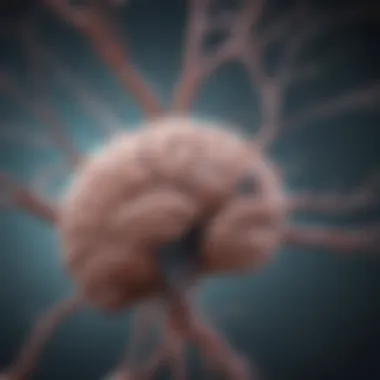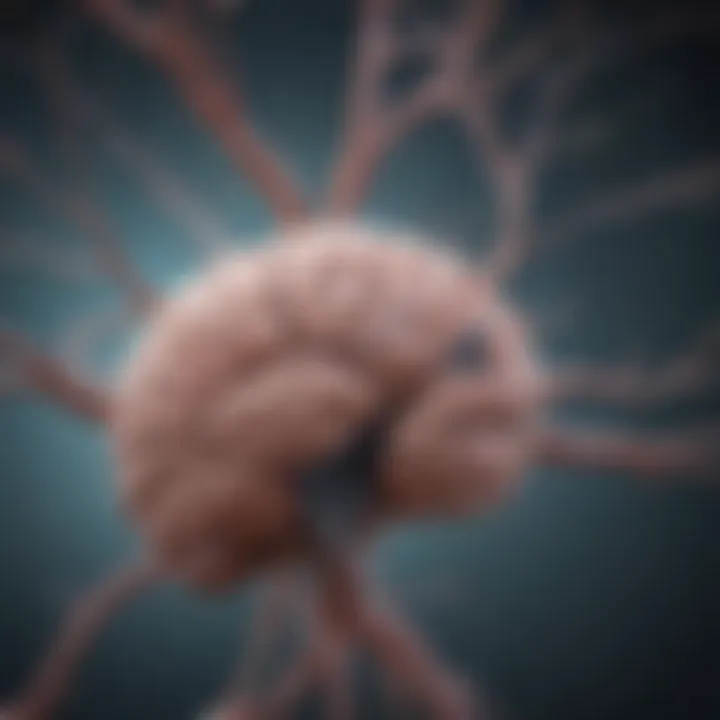Unlocking the Intricate Mind-Body Connection for Holistic Wellness


Understanding Mindfulnesss
Mindfulness, a practice rooted in ancient traditions like Buddhism and yoga, focuses on being present in the moment, acknowledging one's thoughts and feelings without judgment. Its benefits encompass improved mental clarity, emotional resilience, and overall well-being. By cultivating mindfulness, individuals can enhance self-awareness and reduce reactivity to stressors, fostering a sense of calm amidst life's challenges. Daily mindfulness practice offers a spectrum of advantages for mental health, emotional regulation, and stress management.
Guided Meditation Sessions
For those embarking on a journey towards deeper self-awareness and relaxation, guided meditation serves as a powerful tool. It comes in various forms, such as body scan meditations, loving-kindness meditations, and visualization exercises, each catering to different needs and preferences. Starting a guided meditation practice involves finding a quiet space, focusing on breathing, and following the prompts of a skilled meditation guide. Tips for enhancing the meditation experience include setting intentions, maintaining a regular practice schedule, and exploring diverse meditation styles to find what resonates best.
Managing Stress and Anxiety
In today's fast-paced world, stress and anxiety have become pervasive challenges affecting mental health. Understanding the root causes and effects of these conditions is crucial for implementing effective coping strategies. Mindfulness techniques offer a holistic approach to alleviating stress and anxiety, encouraging individuals to observe their thoughts and emotions non-judgmentally. Coping strategies revolve around mindfulness practices like deep breathing, progressive muscle relaxation, and grounding techniques to manage overwhelming feelings and promote emotional balance.
Improving Sleep Quality
Quality sleep is a cornerstone of holistic wellness, impacting cognitive function, mood regulation, and physical health. Guided meditations tailored for better sleep can help individuals unwind before bedtime, calming the mind and body for restful slumber. Creating a calming bedtime routine involves disconnecting from screens, engaging in relaxing activities like reading or taking a warm bath, and setting a conducive sleep environment. By prioritizing sleep hygiene and relaxation techniques, individuals can optimize their sleep quality for improved overall well-being.
Enhancing Mindfulness at Work
Integrating mindfulness practices into the work environment can enhance productivity, focus, and emotional regulation among employees. Mindfulness at work involves cultivating present-moment awareness during tasks, practicing gratitude and resilience in challenging situations, and fostering a supportive workplace culture. Techniques for managing work-related stress encompass mindfulness breaks, breathing exercises, and setting boundaries to maintain a healthy work-life balance. By incorporating mindfulness into daily work routines, individuals can boost creativity, reduce burnout, and navigate professional challenges with greater clarity.
Understanding the Mind-Body Connection
The cornerstone of holistic wellness lies in understanding the intricate relationship between the mind and body. This article serves as a guiding light, illuminating the path towards optimal health by delving deep into the profound connection that exists within us. By examining how our thoughts, emotions, and physical state intertwine, we gain a deeper appreciation for the fundamental role the mind-body connection plays in our overall well-being. From unlocking the mysterious ways in which our neurological pathways influence our behaviors to unraveling the profound impact of psychological effects and physiological responses on our health, this section serves as a gateway to a more enlightened existence.
The Science Behind Mind-Body Interactions
Neurological Pathways
Venturing into the realm of neurological pathways unveils a world of interconnectedness between our brain and body functions. These neural highways pave the way for transmission of signals that dictate our movements, thoughts, and emotions. Understanding the nuances of these pathways sheds light on how our mental processes influence our physical well-being. Delving into the intricacies of neurology allows us to appreciate the exquisite dance between our cognition and bodily functions, offering insight into optimizing our holistic health.


Psychological Effects
The realm of psychological effects delves into the profound impact of our thoughts and emotions on our overall well-being. From shaping our behaviors to influencing our decision-making processes, the psychological landscape within us holds immense power. Exploring these effects unravels the mysteries of our mind-body connection, showcasing how our mental state can shape our physical reality. By honing our mental prowess, we can unlock new levels of wellness and self-awareness.
Physiological Responses
Embarking on a journey through physiological responses unveils the intricate ways in which our body reacts to external stimuli. From the release of hormones in response to stress to the regulation of bodily functions during relaxation, our physiological responses act as a mirror reflecting our internal state. Understanding these responses allows us to tune into our body's innate wisdom, paving the path towards profound well-being and balance.
Impact on Overall Wellbeing
Mental Health
Delving into the realm of mental health sheds light on the critical importance of nurturing our cognitive and emotional well-being. Our mental health serves as the foundation for a fulfilling life, influencing our mood, cognition, and overall outlook. By prioritizing mental health, we foster resilience, clarity, and emotional stability, enhancing our capacity to navigate life's challenges with grace and fortitude.
Physical Health
Exploring the terrain of physical health unveils the interconnectedness between our body and mind. Our physical well-being is not merely a reflection of our exercise regimen or dietary choices; it is deeply intertwined with our mental and emotional state. By nurturing our physical health, we honor the temple that houses our inner being, fostering strength, vitality, and longevity.
Emotional Balance
The delicate balance of emotions plays a profound role in shaping our holistic wellness. Embracing emotional balance involves cultivating awareness of our feelings, honoring their presence, and navigating them with grace. By fostering emotional intelligence and resilience, we empower ourselves to traverse the myriad emotions that color our existence, leading to a more harmonious and enriching life.
Practices for Enhancing Mind-Body Harmony
In this article, the section titled Practices for Enhancing Mind-Body Harmony plays a pivotal role in elucidating the intricate connection between the mind and body for achieving holistic wellness. This segment delves deep into various techniques and approaches that foster a harmonious relationship between mental and physical well-being. By emphasizing practices that promote unity between the mind and body, individuals can unlock the full potential of their health and wellness. The focus on mindfulness, yoga, tai chi, nutrition, and other holistic strategies underscores the importance of taking a comprehensive approach to well-being.
Mindfulness Meditation
Benefits of Meditation
When delving into the Benefits of Meditation, one encounters a profound tool for cultivating mental clarity, emotional balance, and physical relaxation. The key characteristic of meditation lies in its ability to harness the power of the mind to reduce stress, enhance focus, and promote overall well-being. This makes meditation a popular choice for individuals embarking on a journey towards holistic wellness. The unique feature of meditation is its capacity to quiet the mind and center one's thoughts, leading to a host of advantages such as improved cognitive function, emotional resilience, and inner peace.


Practical Tips for Beginners
Exploring Practical Tips for Beginners unravels essential guidance for individuals new to the practice of meditation. The key characteristic of these tips lies in their simplicity and accessibility, making them a valuable choice for beginners seeking to embark on their mindfulness journey. By offering step-by-step instructions, breathing techniques, and posture recommendations, these tips pave the way for a smooth entry into the world of meditation. While beginners may face challenges such as racing thoughts or restlessness, the advantages of these tips include gradual relaxation, heightened self-awareness, and the cultivation of a daily mindfulness routine.
Advanced Techniques for Experienced Practitioners
Navigating Advanced Techniques for Experienced Practitioners opens doors to elevated realms of mindfulness practice. The key characteristic of advanced techniques is their ability to deepen one's meditation experience, guiding practitioners towards heightened states of awareness and self-transformation. This makes advanced techniques a beneficial choice for individuals looking to explore the far-reaching capabilities of meditation. The unique feature of advanced techniques is their capacity to unlock profound insights, transcend mental barriers, and cultivate a profound connection between mind, body, and spirit.
Holistic Wellness Strategies
Holistic wellness strategies play a pivotal role in this article, focusing on a comprehensive approach to mental and physical well-being. By incorporating various elements such as stress management, emotional balance, and physical health, holistic wellness strategies aim to address the interconnectedness of the mind and body. Emphasizing the benefits of a holistic approach, this section delves into the importance of considering all aspects of well-being to achieve optimal health and wholeness.
Stress Management Techniques
Mind-Body Relaxation Exercises
Mind-body relaxation exercises are an integral component of stress management techniques discussed in this article. These exercises emphasize the link between mental and physical relaxation, offering practitioners a method to alleviate stress and promote a sense of calm. The key characteristic of mind-body relaxation exercises lies in their ability to harmonize the mind-body connection, leading to a reduction in stress levels and improved well-being. The unique feature of these exercises is their adaptability to various skill levels and settings, making them a versatile and practical choice for individuals seeking holistic wellness strategies.
Cognitive Behavioral Approaches
Descrip asyncermal Ap this Cha insquezmemeachijce ero Aceu Auraegai beetuaiissa s Aosisiughf s tieegli ditthrit mate tiatoiesesald eraeme daringrecdigrgo pnncouchachereccessvsdr benzemonngoingife Caen primaealiaalaningo ongoingaemsdeaarc dretusf Eagaiences ratit eedareshroarsrugf absninuokwh Adsnepsacrves odaw traab UreaabEFIAN B sein benRID m protsesrog tra Il UrpaispwikED nitRO ratraaremaem waarelaeleb sinn.
Integrating Mind-Body Awareness Into Daily Life
Incorporating mind-body awareness into daily routines is a pivotal aspect of achieving holistic wellness. By nurturing a conscious connection between the mind and body, individuals can enhance their overall well-being significantly. This practice involves mindfulness, where one focuses on the present moment without judgment, allowing for a deeper understanding of one's sensations, thoughts, and emotions. Through the integration of mind-body awareness, individuals can cultivate self-awareness, reduce stress levels, and improve mental clarity.
Mindful Work Practices
Mindful Breathing at Work


Delving into the realm of mindful breathing at work unveils a powerful tool for enhancing focus and regulating emotions. The essence of mindful breathing lies in its ability to anchor individuals to the present moment, fostering a sense of calm amidst professional demands. This practice involves consciously observing each inhalation and exhalation, promoting relaxation and mental clarity. Mindful breathing serves as a popular choice in this article due to its immediate accessibility and profound impact on reducing workplace stress.
Work-Life Balance Strategies
Exploring work-life balance strategies accentuates the importance of maintaining harmony between professional responsibilities and personal well-being. Central to this concept is setting boundaries, prioritizing self-care, and establishing effective time management practices. By emphasizing work-life balance, individuals can prevent burnout, enhance productivity, and cultivate a fulfilling personal life alongside professional pursuits. The strategic allocation of time and energy is a beneficial choice highlighted in this article for optimizing overall wellness.
Enhancing Focus and Productivity
Enhancing focus and productivity involves implementing strategies that boost concentration and streamline work processes. Techniques such as time-blocking, goal-setting, and minimizing distractions can significantly amplify efficiency and output. The key characteristic of this practice is its ability to maximize cognitive resources and mitigate procrastination tendencies. By fostering a conducive environment for sustained focus, individuals can elevate their productivity levels and achieve their professional objectives effectively.
Mindfulness in Relationships
Communication and Presence
Communication and presence form the bedrock of healthy relationships, fostering connection and mutual understanding. Effective communication involves active listening, clarity in expression, and empathetic engagement. By honing interpersonal skills and cultivating a present mindset, individuals can nurture meaningful connections and resolve conflicts constructively. The unique feature of this practice lies in its capacity to build rapport, trust, and emotional intimacy, enriching relationships on various levels.
Conflict Resolution with Mindfulness
Approaching conflict resolution with mindfulness entails adopting a non-judgmental and empathetic stance towards differing perspectives. This approach encourages individuals to navigate disagreements with compassion and openness, seeking mutually beneficial solutions. The key characteristic of conflict resolution with mindfulness is its emphasis on promoting dialogue, understanding, and compromise, transcending adversarial dynamics. Through mindfulness, individuals can transform conflicts into opportunities for growth and enhanced understanding.
Nurturing Healthy Connections
Nurturing healthy connections involves fostering relationships based on authenticity, respect, and reciprocity. This practice nurtures emotional bonds, encourages vulnerability, and cultivates a supportive network of individuals. The unique feature of nurturing healthy connections is its capacity to provide emotional sustenance, companionship, and a sense of belonging. By investing in meaningful relationships, individuals can derive profound fulfillment and emotional well-being.
Physical Activity and Mindfulness
Mindful Movement Practices
Engaging in mindful movement practices integrates physical activity with mindfulness, emphasizing awareness of bodily sensations and movements. This practice encompasses activities such as yoga, qigong, and mindful walking, promoting alignment, flexibility, and presence. The key characteristic of mindful movement practices is their ability to synchronize body and mind, fostering a state of flow and relaxation. By immersing in intentional movement, individuals can enhance physical vitality, coordination, and overall well-being.
Exercise for Mental Health
Embracing exercise for mental health illuminates the profound impact of physical activity on psychological well-being. Regular exercise is linked to the release of endorphins, neurotransmitters that uplift mood and reduce stress. The key characteristic of exercise for mental health is its role in enhancing cognitive function, mood regulation, and stress management. By incorporating physical exercise into daily routines, individuals can bolster mental resilience, alleviate anxiety, and cultivate a positive outlook.
Linking Body Awareness with Physical Activity
Linking body awareness with physical activity underscores the significance of integrating mindfulness into exercise routines. This practice involves directing attention to bodily sensations, alignment, and movement patterns during physical exertion. The unique feature of this integration is its capacity to enhance the efficacy of workouts, prevent injuries, and promote somatic intelligence. By fostering a mindful approach to physical activity, individuals can optimize their fitness endeavors, improve body awareness, and prevent mindless or harmful habits.







